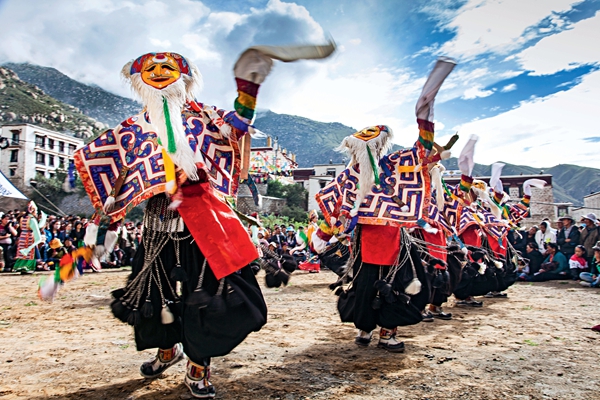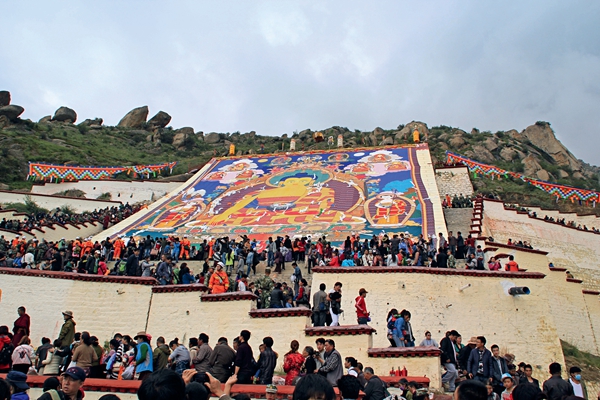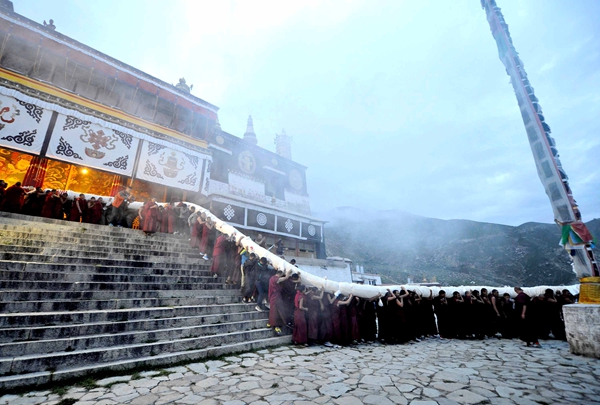Celebrating the Yogurt Festival
ACCORDING to the Tibetan calendar, the Shoton Festival is traditionally celebrated from the end of the sixth month to the beginning of the seventh month in areas inhabited by people of Tibetan ethnicity, such as Tibet, Qinghai, Gansu, Sichuan, and Yunnan. Following the Tibetan New Year, the Shoton Festival is one of the most important festivals for Tibetans. In the Tibetan language, “Shoton” means “yogurt banquet”; therefore, the festival is also known as the Yogurt Festival. During the celebration, people can watch Tibetan Opera and worship giant Buddha images painted on Thangka scrolls. As such, the festival is also called the “Festival of Tibetan Opera” and the “Sunning of the Buddha.”
 Tibetan Opera is a performance art which combines drama, dance, music, and rhyming lines. Performers dance and sing to extend their propitious wishes to the audience.
Tibetan Opera is a performance art which combines drama, dance, music, and rhyming lines. Performers dance and sing to extend their propitious wishes to the audience.
The traditional Shoton Festival celebrations start with the ceremony of the Sunning of the Buddha and feature activities such as Tibetan Opera performances, horse shows, and yak racing. The celebrations are normally held in Norbulingka in the western suburb of Lhasa. During the festival, Norbulingka and its surrounding woods resemble a newly built city with colorful tents, bustling streets, and busy markets. Everyone sings and dances passionately, with the accompanying music played on Tibetan musical instruments. These are the most vibrant days for local Tibetan people.
The Shoton Festival was officially added to China’s Intangible Cultural Heritage list in 2006.
Origin and Development
The Shoton Festival originated in the middle of the 11th century as a purely religious activity.
It is said that a major taboo of Buddhism is to kill living beings. However, as the weather begins to grow warm in the summer, the trees and grass start to grow and hibernating insects wake up. As such, it’s difficult to avoid killing these small creatures when the monks walk outside the monastery. Therefore, the Gelug, one of the schools of Tibetan Buddhism, stipulated that monks must stay in monasteries for studying and worship from the fourth to sixth month of the Tibetan calendar, and are only allowed to go outside at the end of the sixth month. On the day the ban is lifted, the monks go out and travel down the mountains. People make yogurt and hold banquets for the visiting monks, during which they can also appreciate Tibetan Opera performances. This marks the origin of the Shoton Festival.
 The Sunning of the Buddha, also known as the Buddha-basking Ceremony, is the most eye-catching prelude to the Shoton Festival.
The Sunning of the Buddha, also known as the Buddha-basking Ceremony, is the most eye-catching prelude to the Shoton Festival.
By the second half of the 17th century and the beginning of the 18th century, the theocratic system had been strengthened in Tibet, as the Qing imperial government formally granted the fifth generation of Dalai, then leader of the Gelug sect of Tibetan Buddhism, the title “Dalai Lama,” and gave the fifth generation of Panchen the title “Panchen Erdeni.” In 1642, the Gelug sect wielded the power and the fifth Dalai Lama became leader of the then theocratic Tibet. The Drepung Monastery where he lived became the political, religious, and cultural center of Tibet. On the last day of the sixth month of the Tibetan calendar, thousands of Buddhists swarmed into the monastery to offer yogurt to the Dalai Lama and monks, asking for blessings of longevity, good harvest, and to not go to hell after they die. The nearby troupes also put on performances such as Tibetan Opera and a yak show. As time went by, more activities have been held, making Shoton a grand festival.
According to historical records, the fifth Dalai Lama would personally watch the Tibetan Opera on the day of the festival. That same day, another spiritual leader dubbed the “iron rod” lama would take office. The “iron rod” lama was responsible for making sure every monk observed the rules and prohibitions and managed the monks in the monastery and Dratsang (a school in the monastery for monks to study Buddhist doctrine). His title was derived from the fact that he often brought an iron rod with him when inspecting the monastery.
The inclusion of the Tibetan Opera in the Shoton Festival signifies the religious event gradually evolved into cultural and entertainment activities. However, the celebration was still confined inside the monastery, with the Drepung Monastery as the center. Therefore, the festival was also called Drepung Shoton Festival.
After the white palace of the Potala Palace were finally built, the fifth Dalai Lama moved there from the Drepung Monastery. The following generations of Dalai Lama all settled in the Potala Palace, where they lived and carried out religious activities, making the palace a sacred place for lamas and Buddhists to pay homage. When celebrating the Shoton Festival, the joint performance of Tibetan Opera was first carried out in the Drepung Monastery, and then in the Potala Palace for the Dalai Lama.
 A giant Thangka is carried by scores of lamas all the way to the big platform built along the hillside, where it is finally unfolded and displayed.
A giant Thangka is carried by scores of lamas all the way to the big platform built along the hillside, where it is finally unfolded and displayed.
The seventh Dalai Lama suffered from many illnesses in his later years. The physicians advised him to live in Norbulingka and have a bath there with running water to preserve his health. Following this advice, he stayed in Norbulingka every summer until he passed away. By the period of the eighth Dalai Lama, the construction of Kelzang Podrang Palace was completed in Norbulingka and has gradually become the de facto summer palace for Dalai Lamas. Therefore, the main venue for celebrating the Shoton Festival was transferred to Norbulingka and ordinary people have been allowed to enter to watch Tibetan Opera performances. In this way, the Shoton Festival has gradually become a festival for everyone.
Since 1959, when the democratic reform was conducted in Tibet, the Shoton Festival celebrations have been further enriched. During the festival, residents near Lhasa City gather together to go to Norbulingka, bringing barley wines and their luggage. In addition to local Tibetan Opera troupes, other troupes from Qinghai, Gansu, Sichuan, and Yunnan all come to Lhasa to exchange experiences, with an aim to improve their performance skills. Moreover, many song and dance troupes come to put on their performances, making the event even more exciting. Businessmen also seize the opportunity to promote their goods, while still meeting the needs of visitors. The government departments and public institutions in Tibet also organize large-scale song and dance performances, as well as academic symposiums during the Shoton Festival.
Sunning of the Buddha
The Sunning of the Buddha, also known as the Buddha-basking Ceremony, is the most eye-catching prelude to the Shoton Festival. Every year on the last day of the sixth month of the Tibetan calendar, Buddhists display the giant Thangka of Great Buddha on the hillside of the Drepung Monastery for tourists and devout believers to worship.
The Drepung Monastery was built in 1416 by Tsong Khapa’s fourth disciple Jamyang Choskyi. Tsong Khapa is the founder of the Gelug sect of Tibetan Buddhism. Now, the 250,000-square-meter monastery is the biggest Buddhist temple in Tibet, with a 4,500-square-meter architectural complex of the Tsochin Assembly Hall, Buddhas of Three Periods Hall, Four Dratsangs, and Gaden Podrang Hall. All these buildings are surrounded by white exterior walls which look like large piles of rice from a distance, and thus the monastery was named “Drepung,” meaning “piles of rice” in the Tibetan language.
Originating from the period of the fifth Dalai Lama, the Buddha-basking Ceremony in the Drepung Monastery usually starts before daybreak when disciples and visitors converge from all directions onto the solemn and respectful square of the Tsochin Assembly Hall, waiting patiently for the sacred ceremony.
At dawn, guided by Buddhists holding ritual instrument in hands, the giant Thangka in the monastery will be carried by scores of lamas all the way to the big platform built along the hillside to finally unfold and display. Crowds of people immediately make way for the Great Buddha, soon converging and then joining the long queue walking forward. The participation in the transportation of the Thangka with Buddha Sakyamuni’s image is such an honor, that even people far away will throw different colors of Khada, a brightly colored scarf, and mascots to show their homage and blessing.
In the first ray of sunshine, as the blaring horn and scripture reciting goes on, a huge figure of Sakyamuni embroidered in color is gradually unfolded on the cliffs, approximately six or seven stories high, showcasing a solemn and peaceful countenance of the Great Buddha. Then, followers will begin to worship and present Khada, and pray for safety, happiness, and fortune.
The ceremony lasts for the whole morning and at around 2 pm, the giant Thangka will be cautiously rolled up and escorted back to the Drepung Monastery, to wait for next year’s Shoton Festival.
– Gala in Norbulingka
Most activities of the Shoton Festival are celebrated in Norbulingka in the western suburb of Lhasa. In the Tibetan language, “Norbulingka” means “treasure garden.” Norbulingka Park used to be the Summer Palace of Dalai Lama. At each year’s Shoton Festival, people will get together with family members in Norbulingka, set up colorful tents and carpets, and bring beverages and delicacies to enjoy the blissful time. Under the straight white poplars, on the green grassland, along the river bank, Tibetan people with flamboyant costumes sitting in groups of three or five can be seen everywhere, singing, dancing, drinking, or playing chess.
Tibetan Opera shows are performed on the second day of the Shoton Festival, at which point Opera troupes will continually sing every morning from 11 am until night falls.
Besides the traditional Buddha display, the Shoton Festival is now more enjoyable with art shows, horse races, hiking conventions around the Namtso Lake, and a “Shoton Star” singer contest; in addition, business negotiations, merchandise exhibitions, tourism and entertainment are all included.
– Thangka
Thangka is a scroll painting with Tibetan Buddha images on silk, often kept unframed and rolled up when not on display, with a further silk cover on the front. Tibetan history, politics, culture, and social life can all be depicted on this scroll in a religious and ethnic style. Thangka, passed down from generation to generation, are all made from precious materials such as gold, silver, pearl, agate, coral, turquoise, malachite, and cinnabar; and are painted with herbal dyes made from saffron, Chinese rhubarb, and indigo.
The natural materials ensure that bright colors don’t fade after hundreds of years. The process to make a Thangka is often complicated and adheres to a series of strict standards, including the painting prelude, canvas making, picture composition, coloring and dyeing, drawing the outline, dyeing the gold and silver colors, highlighting eyes on the countenance, and stitching brocade; and then the Thangka must be blessed by eminent monks. The whole process will take at least half a year, while some complicated ones need more than 10 years.
– Tibetan Opera
The Tibetan Opera usually has three main parts: a prelude, an episodic show, and an ending ceremony. In the prelude dance, characters perform paying homage to deities, praying, blessing, and give a brief introduction to the plot; the episodic show presents the audience with different stories in various performance forms, from singing and dancing to rhyming lines and monologue; while in the ending ceremony, as drums and cymbals play, all performers will dance and sing and at the same time, extend their propitious wishes to the audience.
(Compiled by China Today)



